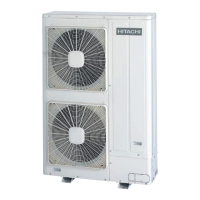¿ Gas stop valve
Check
that the high pressure valves -A- and low pressure valves
-J- are completely closed.
Connect the charge pipe to the stop valves -B- and release gas
from the high pressure pipe -C- and low pressure pipe -I-.
Cut off the end -D- of the stop pipe -E- (ø6.35) and check that there
is no gas in the high and low pressure gas pipe.
Remove the covers -F- from the stop valve.
D A N G E R
Check that
there is no gas inside the pipe before removing the
stop pipe. Otherwise, the pipe may explode when heated with
the blow torch.
Remove the stop pipes at the welded section -G- using a blow torch
-K-. Special care should be taken to ensure that the flame from the
blow torch does not fall on the body of the stop valve -A- and -J-,
on the compressor -N- and cover or on the insulation bushings by
inserting a metal plate -L- in front of the oil return pipe -M-.
¿ Details of the gas and liquid stop valves
1. Gas valve.
2. Liquid valve.
A. Plug.
Tightening torque
Gas 50–58 Nm
Liquid 30–42 Nm
B. Hexagonal wrench. To open or close the valve.
C. Valve. Turn to the left: open; turn to the right: close.
Tightening torque
Gas, 8-12 HP 18–22 Nm
Gas, 14-18 HP 20–25 Nm
Liquid 7–9 Nm
D. Check joint. Only a flexible charge pipe may be connected.
Tightening torque
Gas 9–14 Nm
Liquid 14–18 Nm
E. Refrigerant gas/liquid pipe.
F. O-ring.
3 Piping work and
refrigerant charge
52
SMGB0065 rev. 1 - 12/2010

